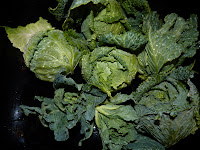 |
| Fall reflections |
What's new? Let's start with the sad sad sad news.... my hive is dead. After taking it apart and asking many experienced beekeepers, it turned out to have been mites, followed by honey robbery from another colony. It was pretty devastating. Apparently, in California, mites come fast and furious, which is why, mite prevention has to start in September and then again in February. Well, I started in October.
BUT we got loads of beeswax, so I will make many candles, salves etc. Of course only after we build (or buy) a beeswax melter.
On the more positive side, all four of our birds are still laying, despite the harsh temperatures. Today in the morning it was 26 degrees Fahrenheit. Brrrrrrr.
What else? Roberto has built an awesome wrought iron tile-mosaic table, which I love! And I have been knitting, crocheting and sewing for Aurelia, me and baby #2 like a mad person. This babe will be the most uniquely dressed wee-one around; including cloth diapers. I am planning on posting a few baby and maternity tutorials shortly, so stay tuned.
 |
| Baking cookies, but first hands washing |
And yes, Aurelia and I baked cookies. . . of course, I ate so many of them right before I had my pregnancy glucose test that now my health care team is convinced that I am at risk for gestational diabetes. No, it's only the holiday season and I baked (and ate) many yummy cookies.
So, I was reviewing my diet with #2 versus the Aurelia pregnancy, from what I recall (mami-nesia, HELLO!). I honestly don't think that I changed anything, mainly because I do not EVAH watch what I eat anyways and simply eat what I like. . . And what I like has not changed. So, the only thing different is that I am not working as a personal trainer anymore, when you are basically active with your clients all day long. Yes, I have turned into a couch-potatoe-cookie-monster. Oh my.
Anywho, you will see Schoko and me now walking and hiking more.
So, on the more interesting subjects: After sowing loads of winter crops, my chickens crossed my plans and scratched up all the seeds. Well, at least someone on the homestead got a meal out of my workings.
So, just like October, November 2011 was not such a great month for us harvesting-wise, either.
Speaking of stolen food... Our labrador girlie has developped a new trait: She gets on her hindlegs and sneaks whatever food is left on the dining room table. And I mean whatever is left on the plates. So far she has not broken any of my good plates but Roberto and Aurelia are determined to catch her doing her dirty deed.
On the growing side: The peas are looking great, growing like crazy (I planted them in the frontyard, where my hungry chickens cannot get to) and I have noticed already some garlic sprouts. So, I am hopeful that we will be harvesting again some time soon. . .
Anywho, without further ado, here is the harvest tally for November 2011:
So, just like October, November 2011 was not such a great month for us harvesting-wise, either.
Speaking of stolen food... Our labrador girlie has developped a new trait: She gets on her hindlegs and sneaks whatever food is left on the dining room table. And I mean whatever is left on the plates. So far she has not broken any of my good plates but Roberto and Aurelia are determined to catch her doing her dirty deed.
On the growing side: The peas are looking great, growing like crazy (I planted them in the frontyard, where my hungry chickens cannot get to) and I have noticed already some garlic sprouts. So, I am hopeful that we will be harvesting again some time soon. . .
Anywho, without further ado, here is the harvest tally for November 2011:
3 lbs Tomatoes
5 lbs Zucchini
1 lbs Eggplant
1 Persimmon (it's a baby-tree)
A total of 9 lbs of produce and 58 duck and 44 chicken eggs.
"Nature never says one thing and wisdom another." Decimus Junius Juvenalis

























